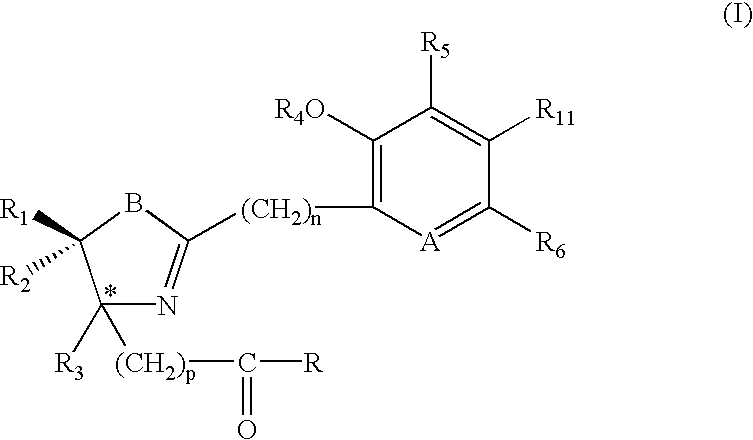Iron binding agents
a technology of iron binding agents and iron, which is applied in the field of malaria treatment, can solve the problems of life-threatening effects, high effective doses, and widespread resistance of plasmodium to chloroquine, and achieve the effect of low toxicity
- Summary
- Abstract
- Description
- Claims
- Application Information
AI Technical Summary
Benefits of technology
Problems solved by technology
Method used
Image
Examples
example 1
Synthesis of Compounds 2,3 5-7,9, 14-17 and 22-24
Compounds 2, 3, 5-7, 9 and 14-17 with the general formula C, were synthesized by cyclocondensation of an o-hydroxyaryl nitrile A with a cysteine derivative B (Scheme 1) (Bergeron et al., J. Med. Chem. 34: 2072-2078 (1991); Bergeron et al., J. Med. Chem. 37:1411-1417 (1994); Bergeron et al., J. Med. Chem. 42: 2432-2440 (1999);(S)- and (R)-DesmethylDFTs 2 were synthesized by condensation of 2-cyano-3-hydroxypyridine, obtained from 3-hydroxypyridine-N-oxide, with D- or L-cysteine, respectively, in pH6 phosphate buffer and methanol. Reaction of 2-hydroxypyridine with D- or L-cysteine provided (S)- and (R)-desazadesmethylDFTs 3, respectively.
The production of (S)-desazaDFT (9), identical to the natural product 4-methylaeruginoic acid (Ryoo et al., J. Antibiot. 50: 256-258 (1997)), and 4′-hydroxydesazaDFT (28) was accomplished by cyclocondensation of 2-cyanophenol or 2,4-dihydroxybenzonitrile, respectively, with (S)-α-methyl cysteine in buf...
example 2
Synthesis of Compounds 18-20
Fused ring DFT analogue J, specifically compounds 18-21, were synthesized by cyclization of an enantiomer of cysteine B (R3═H, B═S, p=0) with an o-hydroxynaphthyl or -quinolinyl nitrile I (Scheme 2) (Bergeron et al., J. Med. Chem. 39: 1575-1581 (1996)).
example 3
Synthesis of Compounds 22-24
Conversion of the carboxylic acid group of (S)-desmethyldesferrithiocin (DMDFT, 2), to an N-methylhydroxarnate or to the pentacoordinate dihydroxamate compound resulted in compounds 22 and 23, respectively (Bergeron, et al., J. Med. Chem. 37: 1411-1417 (1994)).
Compound 24, the N-benzylhydroxamate of 2, was synthesized by N-acylation of N-benzylhydroxylamine hydrochloride with 2 activated by (benzotriazol-1-yloxy)tris (dimethylamino)phosphonium hexafluorophosphate (BOP reagent) in N,N-diiso-propylethylamine (DIEA; 3 equiv) and DMF (Scheme 8). Although it was possible to isolate an optically active hydroxamate via Sephadex LH-20 chromatography, the compound epimerized on recrystallization. The magnitude of optical rotation decreased from [α]D=−16.4° to essentially zero. Because of the spontaneous epimerization, no attempt was made to evaluate the biological properties of optically active materials. The racemic product was utilized in all of the studies.
PUM
| Property | Measurement | Unit |
|---|---|---|
| composition | aaaaa | aaaaa |
| stereoisomers | aaaaa | aaaaa |
| stiffness | aaaaa | aaaaa |
Abstract
Description
Claims
Application Information
 Login to View More
Login to View More - R&D
- Intellectual Property
- Life Sciences
- Materials
- Tech Scout
- Unparalleled Data Quality
- Higher Quality Content
- 60% Fewer Hallucinations
Browse by: Latest US Patents, China's latest patents, Technical Efficacy Thesaurus, Application Domain, Technology Topic, Popular Technical Reports.
© 2025 PatSnap. All rights reserved.Legal|Privacy policy|Modern Slavery Act Transparency Statement|Sitemap|About US| Contact US: help@patsnap.com



